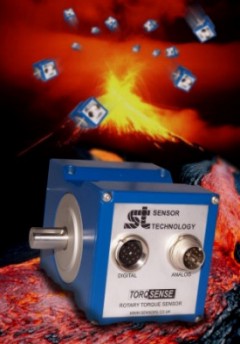Home > Press > Intelligent extruder plans its own growth
 |
| A RWT321 Series Digital TorqSense Sensor |
Abstract:
A bench top extruder developed at Bradford University is able to collect data about its own operation and to determine a wide range of characteristics of the material with which it is working.
Intelligent extruder plans its own growth
Bicester, UK | Posted on October 20th, 2007Most of the intelligence is provided via a digital TorqSense torque sensor, which uniquely collects data via a radio signal rather than being hard wired to the extruder, and passes it onto a computer for analysis.
The extruder, developed under a commercial contract by Dr Raj Patel, supervised by Professor Hadj Benkreira, is specifically for use with fine chemicals, as used in industries such as electronics, plastics, nanotechnology and pharmaceuticals. One element of the design brief was that it should be easy to scale up to create full sized production extruders.
Dr Patel explains: "This requirement immediately made me think of using a TorqSense. Comprehensive mapping of torque requirement and how it varies at different speed and with different materials allows us to quickly define the power train that will be required on production-scale machines."
He had used TorqSense on earlier projects, and particularly liked the fact that it was a digital system with digital outputs and the lack of hard wiring and slip rings made resetting the extruder between the many test runs far simpler and quicker.
"As well as developing the extruder design, we are charged with developing new materials. For instance the semiconductor industry adds conductive carbon to silicon to make silicon wafer substrates. Each such recipe has different mixing and extruding characteristics, which we are measuring."
"Significantly the end users often need to optimise certain characteristics of their materials, such as elasticity or conductivity. Surprisingly many of these can be measured directly through the TorqSense because they have a proportional affect on the material's viscosity and therefore torque requirement."
TorqSense torque transducers, available from Sensor Technology of Bicester, use two tiny ceramic piezoelectric frequency resonating combs otherwise called Surface Acoustic Wave (SAW) devices that are fixed onto the shaft of the torque sensor to measure applied torque. As the torque changes the combs vary their spacing and consequently the resonant frequency of the SAWs changes proportionally to the torque applied in the rotating shaft. In effect the combs are frequency dependent strain gauges that measure changes in resonant frequency of the shaft. A wireless radio frequency (RF) coupling is used to interrogate the SAWs and transfer the data signal to a pick-up head.
The same RF coupling is used to supply power to the SAW devices and because the gauges are based on piezo technology they need less than one milliwatt of power. This arrangement does away completely with the difficulties of fitting slip rings and maintains the measurement quality throughout an extended test run.
TorqSense embraces all the advantages of SAW technology, including no load imparted or extra drag to the drive mechanism under investigation. As it is fundamentally a digital system it has a broader signal bandwidth than other analogue based technologies and electromagnetic interference is eliminated.
This extruder project is a follow-on to earlier work on a mini-mixer for using in formulating high performance plastics, in which a TorqSense played a similar role. The technologies that Dr Patel and his colleagues have developed will transfer directly to the plastic industry and other soft solid sectors giving rapidly recovery of the development costs.
"The software we have developed to analyse the extruder's performance and materials properties," says Dr Patel, "is now being restructured so that it runs on a PLC rather than a PC. As such it will be able to control production sized units in real-time, making them self-adjusting and ensuring perfect results every time."
####
About Sensor Technology
Sensor Technology has been providing customers with rotary torque measurement solutions for over 30 years, developing its own technology for the instrumentation and OEM markets.
Our digital 'RWT310/320 Series' torque sensors includes the latest non-contact TorqSense technology with integrated electronics. We also offer Optical and Strain Gauge technology torque transducers. TorqView, based on NI LabVIEW, is available as an easy to use Advanced Torque Monitoring software tool to assist data recording.
For more information, please click here
Contacts:
Sensor Technology Ltd
68 Heyford Park
Upper Heyford
BICESTER
Oxfordshire OX25 5HD
United Kingdom
Tel: +44 (0)1869 238400
Fax: +44 (0)1869 238401
Email:
Copyright © Sensor Technology
If you have a comment, please Contact us.Issuers of news releases, not 7th Wave, Inc. or Nanotechnology Now, are solely responsible for the accuracy of the content.
| Related News Press |
Announcements
![]() NRL charters Navy’s quantum inertial navigation path to reduce drift April 5th, 2024
NRL charters Navy’s quantum inertial navigation path to reduce drift April 5th, 2024
![]() Discovery points path to flash-like memory for storing qubits: Rice find could hasten development of nonvolatile quantum memory April 5th, 2024
Discovery points path to flash-like memory for storing qubits: Rice find could hasten development of nonvolatile quantum memory April 5th, 2024
Tools
![]() Ferroelectrically modulate the Fermi level of graphene oxide to enhance SERS response November 3rd, 2023
Ferroelectrically modulate the Fermi level of graphene oxide to enhance SERS response November 3rd, 2023
![]() The USTC realizes In situ electron paramagnetic resonance spectroscopy using single nanodiamond sensors November 3rd, 2023
The USTC realizes In situ electron paramagnetic resonance spectroscopy using single nanodiamond sensors November 3rd, 2023
|
|
||
|
|
||
| The latest news from around the world, FREE | ||
|
|
||
|
|
||
| Premium Products | ||
|
|
||
|
Only the news you want to read!
Learn More |
||
|
|
||
|
Full-service, expert consulting
Learn More |
||
|
|
||








